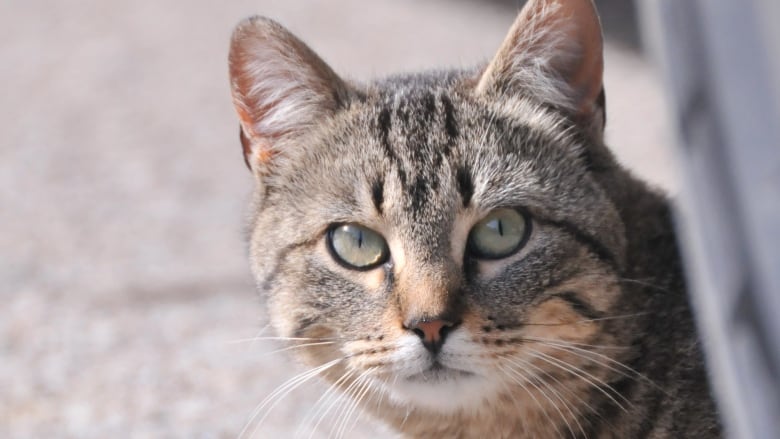City commits $100K to reduce Toronto's feral cat population
'Investment in humanely dealing with cats,' says feral cat advocate

Toronto is contributing$100,000 to help keep the feral cat population under control.
That announcement, made by Coun.Glenn DeBaeremaeker on CBC's Metro Morning on Friday, comes on Feral Cat Awareness Day, a day the city proclaimed to raise awareness around the homeless cats of Toronto.
The Ward 38 councillor said the cash comes from developers who are required to donate money to local community groups.
"So the developers agreed to donate $100,000 to the volunteer program to help them have traps, cages (and)operate the recovery centre, to address the cat over-population problem," De Baeremaeker told Metro Morning.
The money will goto a group of city-affiliated charities called the Feral Cat Coalition, who will decide how best to direct the funds.
"This is an investment in humanely dealing with cats," said Jacqueline Chan ofAnnex Cat Rescue, a member of the coalition.
She said the coalition willputfunds toward the city-backed trap-neuter-release (TNR) program. It is a system of population control that relies on volunteers catching feral cats and bringing them to the city's recovery centre in Scarborough, according to De Baeremaeker.
"They are housed there like a health spa for the day," he said."They go and they get their free spay or neuter operation at the City of Toronto animal hospital."
The cats are allowed to recover for a couple of days and then are brought back to the neighbourhood in which they were caught. A similar programhas been successful in New York, according to Toronto Animal Services.
To residents who don't want the cats returned to their neighbourhood, De Baeremaekersays simply moving cats out of an area won't prevent more from moving in.
"If you do the neuter release program, what happens is that cat population will go down over time and they will disappear over time," he said. "Otherwise, the cats will just move back into your neighbourhood."
The average lifespan for a street cat is three years, he added.
"It's not a very romantic or nice lifestyle," he said. "Some of us think that it's wonderful that the cat's out in the back alley and having fun and impregnating other cats. For that cat he's not likely to live more than three years."
To support the TNR program, the coalition is considering anotherferal cat recovery centre in the city's west end.
Esther Attard, a veterinarian with Toronto Animal Services, said there could be anywhere from 20,000 to 100,000 homeless cats in the city.
"[Cats] can be anuisanceproblem likeraccoons. The bottom line is, though, they are domestic animals that should be pets," she said.
"People love to feed them but that can encourage the growth of a colony."
She said the TNR program has shown it can reduce those numbers.
Trapping in action
The trap-neuter-release program is built upon volunteers who go out, often at night, to get the homeless cats off the streets. There's often an urgency to these rescue missions: the longer an unfixed cat stays out on the street, the higher the likelihood of kittens.
The CBC's Mary Wiens found this out when she accompanied Gary Maker out on a recent trapping expedition in Parkdale.
Along with a few different types of traps, Maker carries with him an assortment of, for lack of a better word baits.
"I've got KFC and tuna," he said, arming a trap with the smelly food.
Trapping a feral cat requires food, and often the more pungent the better. It also requires a lot of patience.
"It can take time," Maker said, having spent many hours collecting catsbut often coming up empty handed.
Maker is one of the city's top three cat trappers, according to Annex Cat Rescue, the charity he works most with. He humanely traps as many as 40 homeless cats a year.
After he catches a cat, he brings it to the Humane Society to get spayed or neutered. After that, it is released back into its neighbourhood where it is cared for by volunteers. In the best case scenarios, the cats can be socialized and adopted out.
In Parkdale, neighbours called Maker after new kittens were appearing since last spring.
A cat the neighbours call Boots was the area tomcat, and responsible for impregnating several other cats. Ever since Boots was neutered, though, another male, Ned, has been making the rounds. Now a female named Gracie is pregnant again.
Maker listens to these types of stories nearly every time he goes out trapping. Cats are efficient reproducers, and can start having kittens at as young as six months old.
On this night, the tomcat fell for the fried chicken, andNed is captured.
The next morning, Maker brings Ned to the Toronto Humane Society to have him sterilized. Gracie, the pregnant female, will have to be caught on another night.
But, as Maker promised, her reproducing days are numbered. And, at least in this one corner of the city, that means no new kittens to face a cold Toronto winter for the time being.












_(720p).jpg)


 OFFICIAL HD MUSIC VIDEO.jpg)
.jpg)



























































































